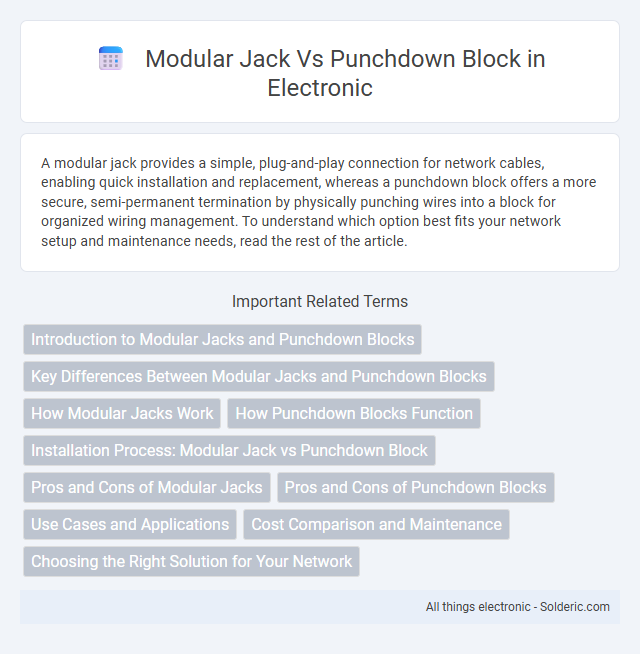A modular jack provides a simple, plug-and-play connection for network cables, enabling quick installation and replacement, whereas a punchdown block offers a more secure, semi-permanent termination by physically punching wires into a block for organized wiring management. To understand which option best fits your network setup and maintenance needs, read the rest of the article.
Comparison Table
| Feature | Modular Jack | Punchdown Block |
|---|---|---|
| Definition | Connector with snap-in ports for quick cable termination | Fixed block for permanently terminating cables via punchdown tool |
| Common Use | Telecommunications, Ethernet ports | Telecom wiring closets, structured cabling patch panels |
| Cable Type | Typically used with stranded or solid 4-8 conductor cables | Typically used with solid multi-conductor cables (e.g., CAT5, CAT6) |
| Installation | Simple plug-and-play; no special tools needed | Requires punchdown tool to insert wires into insulation-displacement contacts |
| Maintenance | Easy replacement and reconfiguration | More permanent; harder to change once installed |
| Durability | Moderate; subject to wear from repeated insertions | High; robust connection with minimal signal loss |
| Cost | Generally lower per unit | Higher initial cost, but suited for large-scale wiring |
Introduction to Modular Jacks and Punchdown Blocks
Modular jacks and punchdown blocks serve distinct roles in telecommunications and networking, with modular jacks acting as connectors for plugging in cables like Ethernet or telephone lines. Punchdown blocks provide a secure method for terminating and organizing multiple wires in structured cabling systems, ensuring reliable signal transmission. Understanding the differences between these components helps you optimize your network installation and maintenance.
Key Differences Between Modular Jacks and Punchdown Blocks
Modular jacks, commonly used for connecting telephone and network cables, feature a plug-and-socket design that allows easy insertion and removal of cables, ideal for end-user device connections. Punchdown blocks serve as a termination point in structured cabling systems, where individual wires are punched down into slots to establish reliable, organized connections for distribution and management of multiple lines. Understanding these key differences helps you select the appropriate hardware for efficient network setup and maintenance.
How Modular Jacks Work
Modular jacks function by providing a standardized physical interface for connecting telecommunications or network cables, typically used in Ethernet or telephone systems. They consist of a plastic housing with metal contacts that align with the pins on the modular plug, ensuring a secure and reliable electrical connection. When the plug is inserted, the contacts in the jack press against the conductive terminals on the plug, enabling data or voice signal transmission.
How Punchdown Blocks Function
Punchdown blocks function by securely connecting and organizing multiple telephone or network wires through individual metal slots that cut into the wire insulation, ensuring reliable contact without soldering. Each wire is punched down using a specialized tool, which presses the conductor into a metal slot, maintaining a stable electrical connection ideal for structured cabling in telecom systems. This method supports high-density wiring environments, enabling efficient signal distribution and easy maintenance compared to modular jacks.
Installation Process: Modular Jack vs Punchdown Block
The installation process of a modular jack involves simply snapping the jack into a faceplate or patch panel and connecting pre-terminated cables, making it faster and more user-friendly, especially for quick changes or moves. Punchdown blocks require manually inserting individual wires into IDC terminals using a punchdown tool, providing a more permanent and secure termination but demanding greater skill and time. Modular jacks are preferred for environments needing frequent reconfigurations, while punchdown blocks are ideal for structured cabling systems offering durability and resistance to signal interference.
Pros and Cons of Modular Jacks
Modular jacks offer easy installation and quick connectivity for Ethernet and telephone wiring, making them ideal for environments requiring frequent changes or upgrades. Their plug-and-play design reduces installation time and maintenance costs, but they can be less durable than punchdown blocks in high-traffic or industrial settings. You may find modular jacks less suitable for complex, large-scale wiring systems where punchdown blocks provide more secure and organized cable management.
Pros and Cons of Punchdown Blocks
Punchdown blocks offer reliable and secure connections for network cabling, reducing signal interference and ensuring stable performance in structured wiring systems. They support high-density wiring, making them ideal for large installations, but require specialized tools and skilled technicians for installation and maintenance. Limited flexibility in reconfiguration and potential damage to cables during termination are notable drawbacks compared to modular jacks.
Use Cases and Applications
Modular jacks are commonly used in residential and office environments for quick and easy Ethernet or telephone cable connections, supporting flexible setups and frequent reconfigurations. Punchdown blocks excel in structured wiring systems and telecommunications closets, providing durable, organized, and permanent termination for large volumes of cables in network infrastructures. Your choice depends on whether you need the convenience of plug-and-play connections or the robustness of fixed, high-density cable management.
Cost Comparison and Maintenance
Modular jacks generally offer lower initial costs due to their ease of installation and compatibility with standard Ethernet cables, while punchdown blocks often involve higher labor expenses because of the manual wiring process. Maintenance for modular jacks is simpler, as replacements can be done quickly without specialized tools, whereas punchdown blocks require periodic testing and skilled personnel to ensure proper connection integrity. Both systems impact ongoing costs differently, with modular jacks favoring quick fixes and punchdown blocks benefiting long-term stability in structured cabling environments.
Choosing the Right Solution for Your Network
Modular jacks provide quick, versatile connections ideal for environments requiring frequent changes or expansions, supporting high-speed data transmission standards such as Cat6 and Cat6a. Punchdown blocks offer a secure, permanent termination method, minimizing signal loss and enhancing reliability in structured cabling setups, especially for large-scale enterprise networks. Selecting the right solution depends on network size, desired scalability, and maintenance preferences, with modular jacks favored for flexibility and punchdown blocks preferred for stability in complex installations.
Modular jack vs Punchdown block Infographic

 solderic.com
solderic.com